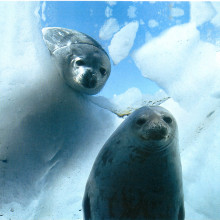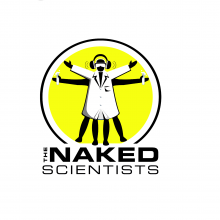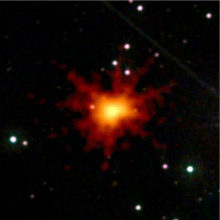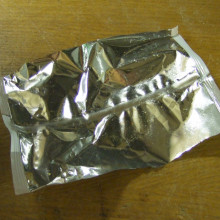Stars, Cosmology and the Beginning of the Universe
This week we dive into deep time as cosmologist Mike Hobson explains how we measure the universe, the distance of the nearest galaxy, how scientists calculate the life span of the sun, and the definition of a light year, Chris Voigt describes how he made a 100 megapixel camera from bacteria, and Derek and Dave cook up a treat in Kitchen Science.
In this episode

- Marine Mammals Seal a Deal With Oceanographers
Marine Mammals Seal a Deal With Oceanographers
A team of oceanographers led by Mike Fedak from the Sea Mammal Research Unit at St Andrews University in Scotland have recruited a new breed of assistants to help them study remote polar waters - seals.
Traditionally, studies of the oceans, which can help in weather prediction and monitoring for climate change, are made by towing probes behind ships in order to measure salinity, depth and water movements. But researchers tend to be limited to studying areas where ships are going already, so some regions, such as the Antarctic, are more difficult to access than others.
Mike Fedak and his team have solved the problem by producing a small fist-sized wearable probe and transmitter which can be attached to an elephant seal's head.
These animals dive forty times a day to depths ranging from 300 to 800 metres to hunt for fish and squid. As soon as a seal resurfaces, data collected by the probe during one of these dives is transmitted to a satellite overhead which relays the data, together with the position of the animal, to the waiting oceanographers.
The team initially tested the devices on two beluga whales in Norway before conducting a larger three-year trial, which concludes in January and involves 70 elephant seals from four breeding areas around the Southern Ocean.

- How to Make a Bacterial Camera
How to Make a Bacterial Camera
with Dr Chris Voigt from the University of California, San Francisco
Chris S - What have you done?Chris V - What we've done is to use genetic engineering to create a strain of bacteria that's able to respond to light. If you look a pond, you'll often see a green sludge. That sludge is sometimes bacteria, and the reason it's green is that the bacteria can photosynthesise. In order to do that, it has to be able to see light. We took a gene from the bacteria you find in ponds and we modified it so that it works in a bacteria that's normally living in your gut. These don't normally have to see light. It's called E. coli. By adding this gene and doing a few more modifications to the genome of E. coli, we made it so that individual E. coli cells are able to see light.
Chris S - When you shine a light on them, what does it do to the bacteria?
Chris V - It has a special type of protein that's on the surface of the bacterium. It's special in that it has a chemical on it that causes the protein to change shape when light is on it. This change in protein shape is recognised by the bacteria, and this leads to turning on a gene. In this way, you can couple shining light on the bacteria to the switching on of a gene.
Chris S - And what sort of things have you made it activate? In the paper you published in Nature this week, you were able to make your bacteria change colour. What else could you do?
Chris V - You could imagine using this for a wide range of applications. If you think about constructing complex materials, such as proteins, they can be very difficult from a chemistry perspective. It would be useful if you were able to print proteins with a very high resolution. We are thinking about using this system to have individual bacteria turn on the production of proteins that produce a particular type of material like spider silk.
Chris S - If you bought this bacteria as a digital camera in the shops, what number of megapixels would it say on the box?
Chris V - If it was able to turn on individual bacteria, it would be about 100 megapixels.
Chris S - So that's a tiny resolution you can work at. You can make really fine structures.
Kat - Are these bacteria dangerous at all?
Chris V - No, they're completely harmless. We're using what is known as a lab strain of E. coli. This differs from natural strains because almost 85% of its genome is missing. This strain of bacteria is used frequently in the lab because it's a very safe strain.

- Why do we like drinks with gas in them?
Why do we like drinks with gas in them?
I think it's the texture. The bubbles in the drink actually make very little contribution to the acidity. Acids generally taste a little bit lemony. However, if you look at drinks like Coca Cola for example, they're so acidic, they'll rot your teeth away. In fact, Coca Cola is on the same level as stomach acid, so the carbonic acid effect from the dissolved carbon dioxide makes very little difference. What the carbon dioxide does do is make a very interesting sensation in your mouth. Firstly, if you think of a glass, you often see a stream of bubbles all coming from one place. This is an imperfection in the glass that makes it very easy for bubbles to form, and is called a nucleation point. Your tongue has hundreds of tiny imperfections, and therefore nucleation points. This makes hundreds of tiny bubbles start pinging off all over your tongue. This is like having your tongue massaged by bubbles. I think this added dimension is what makes fizzy drinks taste good.

What's gravity made of?
That question would probably fox most scientists! There are various theories of gravity. The most straightforward one was put forward by Isaac Newton. He said that it was the force between two bodies that attracts bodies together, and the strength of the force is proportional to the masses of the two bodies over the distance between the two bodies times itself. So the bigger something is, the more it attracts something. There is also the Einstein theory, which is about gravity being the curvature of space time. This is often illustrated by a rubber sheet with a big ball bearing in the middle, which makes a dip. If you then take a smaller ball bearing and ping it off at 90 degrees, it will move round and round the big ball bearing, like an orbiting planet. There are also gravity waves, which are ripples in space time that propagate away from a massive body.

- Is it true that someone's head would explode if you went out into space without a helmet on?
Is it true that someone's head would explode if you went out into space without a helmet on?
If you go into space, there is essentially no pressure. The pressure of any gases you have in your head at the time would expand and potentially split it apart. However, I've never done the sums to see if it could break apart bone. Your body fluids would also boil instantly and evaporate.

- Are gamma ray bursts visible to a naked eye?
Are gamma ray bursts visible to a naked eye?
The retina in the back of your eye is sensitive to a very narrow range of what is called the electromagnetic spectrum. The electromagnetic spectrum contains all of the different wavelengths of light. This includes microwaves, x-rays and gamma rays, but you can't see any of them. Therefore, what you saw wasn't a gamma ray burst.

- Can gravitons escape from a black hole?
Can gravitons escape from a black hole?
That's a very good question. Photons are light particles, and you're quite right in saying that they can't escape from black holes. This is why they look black. Gravitons are thought to mediate gravity, and are massless spin-2 particles. If gravitons couldn't escape from a black hole, you'd have a problem because the black hole wouldn't be able to mediate the gravitational force and you wouldn't feel a gravitational force around it, which we believe isn't the case. There are some quite technical reasons for why particles can mediate a force even though they're in a black hole across the event horizon, but it would take me longer than the rest of this show to explain it.

How far is the nearest galaxy?
The nearest galaxy to our galaxy, the Milky Way, is called Andromeda. It's about 2 million light years away, and we think it looks very similar to our own galaxy. It's difficult to know what our own galaxy looks like because we're in it, but calculations show that it's a flat spiral disc shape. For a long time, people thought that our galaxy was the only galaxy, and that any smudges they saw in the sky were nebulae, which are clouds of gas that form new stars. It was only after some more looking and calculations that people realised that these smudges were too far away to be in our own galaxy. Even Einstein fell foul of misconceptions of that sort. When he was developing his theory of relativity, he had to put in a term that made the universe nice and stable. He thought it consisted of these fixed stars.

- How do scientists check the distances between planets, and how accurate are their methods?
How do scientists check the distances between planets, and how accurate are their methods?
In recent times, the methods have been very accurate because we've sent spacecraft to various planets and can do timing measurements. This is very accurate. In the old days, people had to do incredibly painstaking measurements to see if things were moving a tiny bit. What surprises many people is that Pluto was only discovered in the 1930s, so it's only fairly recently that we've had any idea about the outer reaches of our own solar system.

- Why does the Universe even exist?
Why does the Universe even exist?
Well it's thought that most of the matter we have in the universe today did come from nothing. By nothing, I mean the vacuum. There is a favoured mechanism for creating the matter that fills our universe, and this is the convergence of the energy density of the vacuum. In simple terms, one would think of this as nothing, or no material, into matter. So in many ways, everything we see did come from nothing. The way energy density is converted into matter is quite complicated, but it's thought that that's how it occurred, through inflation.

- How do scientists measure the life of the sun?
How do scientists measure the life of the sun?
We can't actually observe any single star evolving because the time scales involved are far too long. Our sun is sort of middle aged at the moment, and is about 5 billion years old. It should be kicking around for another 5 billion years or so. The way that people understand stars is really by modelling their structure and then observing lots of examples of different stars in different stages of their evolution and seeing if the collection of observations you make fits the theory. We believe that we understand the structure of these stars and so it's really a theoretical construct. We have a model for these stars, it matches all the stars that we see. When we look at the sun, we know what kind of star it is and its properties, and we can say that it's about 5 billion years old.

- How many human years are there in a light year?
How many human years are there in a light year?
A light year is a measure of distance. It's the distance light travels in a year, so it's not a measure of time. Calling them light years'srather confusing I must admit! So it's not the same as converting human years to dog years. They are two different measurements completely.

- Why are we not crushed by gravity at the poles?
Why are we not crushed by gravity at the poles?
It's true that there are both gravitational forces and centrifugal forces acting on us. We're not crushed at the pole because the force of gravity is not strong enough to crush us. In fact, the very small change in gravity with change in latitude is tiny. However, you're right to point this out as it is different between the poles and the equator, however small its effect.











Comments
Add a comment